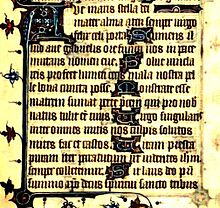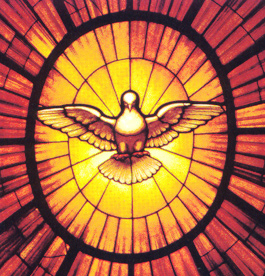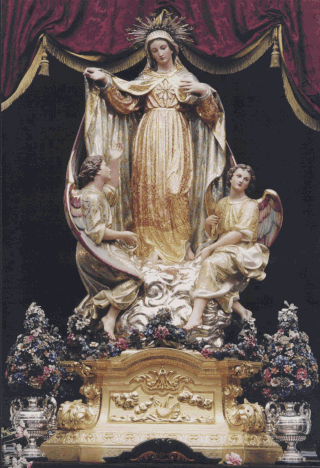
"Ave maris stella" (Latin for 'Hail, star of the sea') is a medieval Marian hymn, usually sung at Vespers. It was especially popular in the Middle Ages and has been used by many composers as the basis of other compositions.

"Ave maris stella" (Latin for 'Hail, star of the sea') is a medieval Marian hymn, usually sung at Vespers. It was especially popular in the Middle Ages and has been used by many composers as the basis of other compositions.
Authorship of the original hymn has been attributed to several people, including Bernard of Clairvaux (12th century), Saint Venantius Fortunatus (6th century) [1] and Hermannus Contractus (11th century). [2] Probably originating in the 9th century, [3] it appears as a 10th century addition in two 9th-century manuscripts, one from Salzburg now in Vienna [4] and the other still at the Abbey of Saint Gall. [5] Its frequent occurrence in the Divine Office made it popular in the Middle Ages, many other hymns being founded upon it. [1] The "Ave maris stella" was highly influential in presenting Mary as a merciful and loving Mother. [6] "Much of its charm is due to its simplicity". [7] The title "Star of the Sea" is one of the oldest and most widespread titles applied to Mary. The hymn is frequently used as a prayer for safe-conduct for travelers. [8]
The melody is found in the Irish plainsong "Gabhaim Molta Bríde", a piece in praise of St. Brigid of Kildaire. [9] The popular modern hymn Hail Queen of Heaven, the Ocean Star , is loosely based on this plainsong original.

The Latin text of the hymn as authorized for use in the Liturgy of the Hours of the Roman Rite (Ordinary Form) is the following: [10]
Ave, maris stella, | Hail, star of the sea, |
| |
| Part of a series on the |
| Mariology of the Catholic Church |
|---|
 |
| |
The plainchant hymn has been developed by many composers from pre-baroque to the present day. The Roman Rite employs four different plainchant tunes for the Ave maris stella; the first three are designated for solemnities, feasts, and memorials of the Blessed Virgin Mary; [10] a fourth is given in the Little Office of the Blessed Virgin Mary as an alternative to the memorial tone. The tunes have been used as the cantus firmus for some polyphonic settings of the mass, including those by Josquin and Victoria. [15]
Renaissance settings include those by Hans Leo Hassler, Felice Anerio, Giovanni Pierluigi da Palestrina, Guillaume Dufay and William Byrd. Baroque settings include Monteverdi's Vespro della Beata Vergine 1610 , one by Emperor Leopold I, one by Louis Couperin in 1658, four settings by Marc-Antoine Charpentier (H.60, H.63, H.65, H.67 1670–1680s), and Sébastien de Brossard. Romantic settings include those by Dvorak, Grieg, and Liszt. Modern composers who have either set the text or used the hymn as an inspiration include Marcel Dupré, Flor Peeters, Peter Maxwell Davies, James MacMillan, Jean Langlais, and others.[ citation needed ]
In 1884, the second Acadian national convention adopted "Ave maris stella" as the anthem of Acadia. [16]

Josquin Lebloitte dit des Prez was a composer of High Renaissance music, who is variously described as French or Franco-Flemish. Considered one of the greatest composers of the Renaissance, he was a central figure of the Franco-Flemish School and had a profound influence on the music of 16th-century Europe. Building on the work of his predecessors Guillaume Du Fay and Johannes Ockeghem, he developed a complex style of expressive—and often imitative—movement between independent voices (polyphony) which informs much of his work. He further emphasized the relationship between text and music, and departed from the early Renaissance tendency towards lengthy melismatic lines on a single syllable, preferring to use shorter, repeated motifs between voices. Josquin was a singer, and his compositions are mainly vocal. They include masses, motets and secular chansons.

"Pange lingua gloriosi corporis mysterium" is a Medieval Latin hymn attributed to Saint Thomas Aquinas (1225–1274) for the Feast of Corpus Christi. It is also sung on Maundy Thursday during the procession from the church to the place where the Blessed Sacrament is kept until Good Friday. The last two stanzas are sung at Benediction of the Blessed Sacrament. The hymn expresses the doctrine that the bread and wine are changed into the body and blood of Christ during the celebration of the Eucharist.
Plainsong or plainchant is a body of chants used in the liturgies of the Western Church. When referring to the term plainsong, it is those sacred pieces that are composed in Latin text. Plainsong was the exclusive form of Christian church music until the ninth century, and the introduction of polyphony.

Gregorian chant is the central tradition of Western plainchant, a form of monophonic, unaccompanied sacred song in Latin of the Roman Catholic Church. Gregorian chant developed mainly in western and central Europe during the 9th and 10th centuries, with later additions and redactions. Although popular legend credits Pope Gregory I with inventing Gregorian chant, scholars believe that it arose from a later Carolingian synthesis of the Old Roman chant and Gallican chant.

The Hail Mary or Angelical salutation is a traditional Christian prayer addressing Mary, the mother of Jesus. The prayer is based on two biblical passages featured in the Gospel of Luke: the Angel Gabriel's visit to Mary and Mary's subsequent visit to Elisabeth, the mother of John the Baptist. It is also called Angelical salutation as the prayer is based on the Archangel Gabriel's words to Mary. The Hail Mary is a prayer of praise for and of petition to Mary, regarded as the Theotokos. Since the 16th century, the version of the prayer used in the Catholic Church closes with an appeal for her intercession. The prayer takes different forms in various traditions and has often been set to music.

The Mass is a form of sacred musical composition that sets the invariable portions of the Christian Eucharistic liturgy, known as the Mass.

In music, monophony is the simplest of musical textures, consisting of a melody, typically sung by a single singer or played by a single instrument player without accompanying harmony or chords. Many folk songs and traditional songs are monophonic. A melody is also considered to be monophonic if a group of singers sings the same melody together at the unison or with the same melody notes duplicated at the octave. If an entire melody is played by two or more instruments or sung by a choir with a fixed interval, such as a perfect fifth, it is also said to be monophony. The musical texture of a song or musical piece is determined by assessing whether varying components are used, such as an accompaniment part or polyphonic melody lines.

Vespro della Beata Vergine, SV 206, is a musical setting by Claudio Monteverdi of the evening vespers on Marian feasts, scored for soloists, choirs, and orchestra. It is an ambitious work in scope and in its variety of style and scoring, and has a duration of around 90 minutes. Published in Venice as Sanctissimae Virgini Missa senis vocibus ac Vesperae pluribus decantandae, cum nonnullis sacris concentibus, ad Sacella sive Principum Cubicula accommodata, it is sometimes called Monteverdi's Vespers of 1610.

Jean (Jehan) Titelouze was a French Catholic priest, composer, poet and organist of the late Renaissance and early Baroque periods. He was a canon and organist at Rouen Cathedral. His style was firmly rooted in the Renaissance vocal tradition and as such, was far removed from the distinctly French style of organ music that developed during the mid-17th century. However, his hymns and Magnificat settings are the earliest known published French organ collections, and he is regarded as the first composer of the French organ school.

Marian hymns are Christian songs focused on Mary, mother of Jesus. They are used in both devotional and liturgical services, particularly by the Roman Catholic, Eastern Orthodox, Oriental Orthodox, Anglican, and Lutheran churches. They are often used in the month of May devotions. Some have also been adopted as Christmas hymns. Marian hymns are not popular among some Protestants, as they see Marian veneration as idolatry. However, the practice is very common among Christians of Catholic traditions, and a key component of the Eastern Orthodox liturgy. There are many more hymns to Mary within the Eastern Orthodox yearly cycle of liturgy than in Roman Catholic liturgy.
"Victimae paschali laudes" is a sequence prescribed for the Catholic Mass and some liturgical Protestant Eucharistic services on Easter Sunday. It is usually attributed to the 11th-century Wipo of Burgundy, chaplain to Holy Roman Emperor Conrad II, but has also been attributed to Notker Balbulus, Robert II of France, and Adam of St. Victor.

"Veni Sancte Spiritus", sometimes called the Golden Sequence, is a sequence prescribed in the Roman Liturgy for the Masses of Pentecost and/or its octave, exclusive of the following Sunday. It is usually attributed to either the thirteenth-century Pope Innocent III or to the Archbishop of Canterbury, Cardinal Stephen Langton, although it has been attributed to others as well.

A paraphrase mass is a musical setting of the Ordinary of the Mass that uses as its basis an elaborated version of a cantus firmus, typically chosen from plainsong or some other sacred source. It was a common means of mass composition from the late 15th century until the end of the 16th century, during the Renaissance period in music history, and was most frequently used by composers in the parts of western Europe which remained under the direct control of the Roman Catholic Church. It is distinguished from the other types of mass composition, including cyclic mass, parody, canon, soggetto cavato, free composition, and mixtures of these techniques.

Our Lady, Star of the Sea is an ancient title for Mary, the mother of Jesus. The words Star of the Sea are a translation of the Latin title Stella Maris.
The Missa Pange lingua is a musical setting of the Ordinary of the Mass by Franco-Flemish composer Josquin des Prez, probably dating from around 1515, near the end of his life. Most likely his last mass, it is an extended fantasia on the Pange Lingua hymn, and is one of Josquin's most famous mass settings.

The Missa de Beata Virgine is a musical setting of the Ordinary of the Mass, by Renaissance composer Josquin des Prez. Though formerly believed to have been a late composition due to stylistic reasons, evidence from Burchard’s Diary proves that the mass was written sometime before September 23, 1497. It was the most popular of his masses in the 16th century.

"Hail, Queen of Heaven, the Ocean Star" is a Marian hymn written by Father John Lingard (1771–1851), a Catholic priest and historian who, through the works of William Cobbett, helped to smooth the passage of the Catholic Emancipation Act in England.

"Rorate caeli" or "Rorate coeli" are the opening words of Isaiah 45:8 in the Vulgate. The text appears at several points in the Christian liturgy during Advent.

Catholic Marian music shares a trait with some other forms of Christian music in adding another emotional dimension to the process of veneration and in being used in various Marian ceremonies and feasts. Marian music is now an inherent element in many aspects of the veneration of the Blessed Virgin Mary in Catholic Mariology.
The Missa Gaudeamus is a musical setting of the Ordinary of the Mass by Franco-Flemish composer Josquin des Prez, probably composed in the early or middle 1480s, and published in 1502. It is based on the gregorian introit Gaudeamus Omnes and its setting is for four voices.
{{cite book}}: CS1 maint: location missing publisher (link)